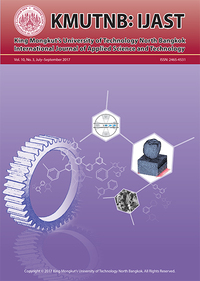Utilization of Organic Wastes for Laccase Production by Pleurotus ostreatus
Main Article Content
Abstract
Production of laccase was achieved by using white-rot fungus, Pleurotus ostreatus, grown on economical and cost-effective materials. The fungus was cultivated in liquid medium containing mung bean pomace, soybean pomace and wastewater treatment sludge as sole carbon source for 15 days. In addition, different concentrations of an inducer, benzyl alcohol, were tested to induce laccase production. The results revealed that the highest laccase activity was equal to 1.859 ± 0.129 U/mL in mung bean pomace containing medium, and the lowest laccase activity was 0.234 ± 0.019 U/mL in soybean pomace medium. Addition of 10 mm benzyl alcohol enhanced laccase production up to 2.952 ± 0.080 U/mL in the mung bean pomace medium at day 15 of cultivation. Level of laccase production increased correspondingly with increasing concentration of the inducer. The high level of laccase production in mung bean medium could contribute to high C/N ratio and excessively high levels of carbon and nitrogen contents in soybean suppressed laccase production.
Article Details
References
[2] X. Hu, X. Zhao, and H.-m. Hwang, “Comparative study of immobilized Trametes versicolor laccase on nanoparticles and kaolinite,” Chemosphere, vol. 66, no. 9, pp. 1618–1626, 2007.
[3] A. Zille, T. Tzanov, G. M. Gübitz, and A. Cavaco-Paulo, “Immobilized laccase for decolourization of Reactive Black 5 dyeing effluent,” Biotechnology Letters, vol. 25, no. 17, pp. 1473–1477, 2003.
[4] G. Bayramoğlu and M. Yakup Arıca, “Immobilization of laccase onto poly(glycidylmethacrylate) brush grafted poly(hydroxyethylmethacrylate) films: Enzymatic oxidation of phenolic compounds,” Materials Science and Engineering: C, vol. 29, no. 6, pp. 1990–1997, 2009.
[5] M. Moeder, C. Martin, and G. Koeller, “Degradation of hydroxylated compounds using laccase and horseradish peroxidase immobilized on microporous polypropylene hollow fiber membranes,” Journal of Membrane Science, vol. 245, no. 1–2, pp. 183–190, 2004.
[6] S. Rodríguez Couto and J. L. Toca Herrera, “Industrial and biotechnological applications of laccases: A review,” Biotechnology Advances, vol. 24, no. 5, pp. 500–513, 2006.
[7] P. S. Soumya, M. S. K. Lakshmi, and P. Nambisan, “Application of response surface methodology for the optimization of laccase production from Pleurotus ostreatus by solid state fermentation on pineapple leaf substrate,” Journal of Scientific and Industrial Research, vol. 75, pp. 306–314, 2016.
[8] O. V. Morozova, G. P. Shumakovich, S. V. Shleev, and A. I. Iaropolor, “Laccase-mediator systems and their applications: A review,” Applied Biochemistry and Microbiology, vol. 43, no. 5, pp. 523–535, 2007.
[9] S. S. Kahraman and I. H. Gurdal, “Effect of synthetic and natural culture media on laccase production by white rot fungi,” Bioresource Technology, vol. 82, no. 3, pp. 215–217, 2002.
[10] P. Tong, Y. Hong, Y. Xiao, M. Zhang, X. Tu, and T. Cui , “High production of laccase by a new basidiomycete, Trametes sp,” Biotechnol Letters, vol. 29, no. 2, pp. 295–301, 2007.
[11] M. Tišma, P. Žnidaršič-Plazl, Đ. Vasić-RačkiBruno, and B. Zelić, “Optimization of laccase production by Trametes versicolor cultivated on industrial waste,” Applied Biochemistry and Biotechnology, vol. 166, no. 1, pp. 36–46, 2012.
[12] M. Mukhopadhyay and R. Banerjee, “Purification and biochemical characterization of a newly produced yellow laccase from Lentinus squarrosulus MR13,” 3 Biotech, vol. 5, no. 3, pp. 227–236, 2014.
[13] H. Patel, A. Gupte, and S. Gupte, “Effect of different culture conditions and inducers on production of laccase by a basidiomycete fungal isolate Pleurotus ostreatus HP-1 under solid state fermentation,” BioResources, vol. 4, no. 1, pp. 268–284, 2009.
[14] J. M. R. d. Luz, S. A. Paes, M. D. Nunes, D. P. Torres, M. C. S. d. Silva, and M. C. M. Kasuya, “Lignocellulolytic enzyme production of Pleurotus ostreatus growth in agroindustrial wastes,” Brazilian Journal of Microbiology, vol. 43, no. 4, pp. 1508–1515, 2012.
[15] Y. J. Park, D. E. Yoon, H. I. Kim, O. C. Kwon, Y. B. Yoo, W. S. Kong, and C. S. Lee, “Overproduction of laccase by the white-rot fungus Pleurotus ostreatus using apple pomace as inducer,” Mycobiology, vol. 42, no. 2, pp. 193–197, 2014.
[16] S. Kurniawati and J. A. Nicell, “Characterization of Trametes versicolor laccase for the transformation of aqueous phenol,” Bioresource Technology, vol. 99, no. 16, pp. 7825–7834, 2008.
[17] R. Bourbonnais, M. G. Paice, B. Freiermuth, E. Bodie, and S. Borneman, “Reactivities of various mediators and laccases with kraft pulp and lignin model compounds,” Applied and Environmental Microbiology, vol. 63, no. 12, pp. 4627–4632, 1997.
[18] M. Siwulski, K. Drzewiecka, K. Sobieralski, and Y. Chong, “Comparison of growth and enzymatic activity of mycelium and yielding of Pleurotus ostreatus (Fr.) Kumm. on different substrates,” ACTA Scientiarum Polonorum, vol. 9, no. 3, pp. 45–50, 2010.
[19] V. V. Kumar, S. D. Kirupha, P. Periyaraman, and S. Sivanesan, “Screening and induction of laccase activity in fungal species and its application in dye decolorization,” African Journal of Microbiology Research, vol. 5, no. 11, pp. 1261–1267, 2011.
[20] E Birhanli and O. Yesilada, “The utilization of lignocellulosic wastes for laccase production under semisolid-state and submerged fermentation conditions,” Turkish Journal of Biology, vol. 37, no. 4, pp. 450–456, 2013.
[21] A. Tripathi, R. C. Upadhyay, and S. Singh, “Extracellular Ligninolytic Enzymes in Bjerkandera adusta and Lentinus squarrosulus,” Indian Journal of Microbiology, vol. 52, no. 3, pp. 381–387, 2011.


